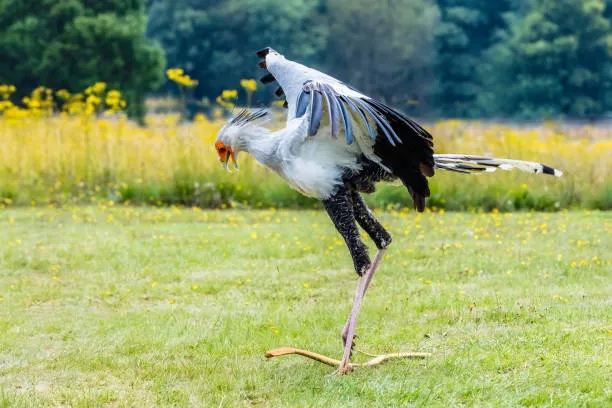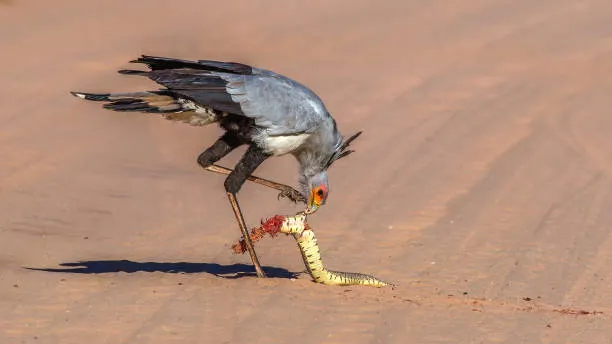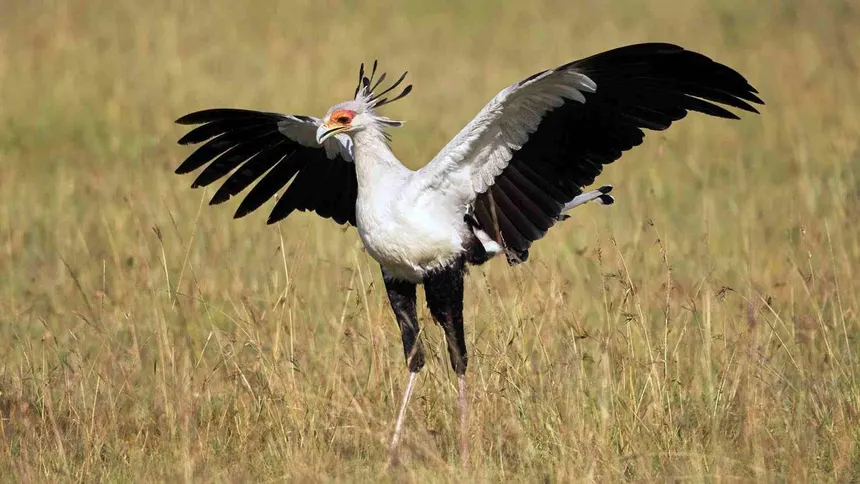7 interesting facts about Secretary Birds

The Secretary Bird (Sagittarius serpentarius) is one of the most unique and easily recognizable birds of prey in the world. Native to the open grasslands and savannas of sub-Saharan Africa, this long-legged raptor is best known for its unusual appearance and incredible ability to hunt and kill venomous snakes. Despite being a bird of prey, the secretary bird hunts primarily on foot and has a body more reminiscent of a crane than a hawk.
Below are seven intriguing facts that uncover the captivating life and behavior of this extraordinary avian predator.
1. 🦅 They Are Raptors—But They Hunt on Foot
Unlike most birds of prey that soar through the skies to catch prey, secretary birds hunt by walking. They travel several miles a day on foot across African grasslands searching for food. They use their strong legs and keen eyesight to locate prey, and then stomp or strike with precision.
Their hunting method is so distinctive that they are sometimes called “the walking eagle.”
2. 🐍 They Are Fearless Snake Killers
One of the most iconic behaviors of the secretary bird is its ability to kill venomous snakes, including cobras and puff adders. Using their powerful legs, they stomp on the snake’s head with incredible force and speed, often delivering over 40 kicks per second.
Their legs are covered in tough scales that protect them from bites. Once the snake is subdued or killed, they swallow it whole or carry it to their nest.

3. 👀 Their Name Has a Curious Origin
There are two main theories behind the name “secretary bird”:
- Early European settlers thought the black feathers at the back of their head resembled the quill pens secretaries tucked behind their ears.
- Their plumage—gray body with black leggings—was said to resemble a 19th-century male secretary in a long-tail coat and trousers.
Either way, the name has stuck and adds to the bird’s quirky appeal.
4. 📏 They Are Among the Tallest Birds of Prey
Secretary birds stand at an impressive 1.2–1.4 meters (4–4.5 feet) tall. Their long legs make them one of the tallest raptors on Earth. Despite this height, they only weigh around 3.5–4.5 kg (8–10 pounds), allowing them to move quickly through open terrain.
Their wingspan can reach over 2 meters (6.5 feet), aiding in gliding flight over large distances when needed.
5. 🧠 They Use Smart Hunting Techniques
Research has shown that secretary birds use intelligent and strategic hunting behavior. They carefully assess the movement of their prey and adjust their kicking angle and force accordingly. Studies have recorded that their kicks generate impact forces similar to a 5-times body weight punch.
They are also opportunistic feeders, sometimes working in pairs to flush out rodents, insects, lizards, or small birds hiding in tall grass.
6. 🪺 Their Nests Are Surprisingly Large and High
Despite being ground-dwelling hunters, secretary birds build their nests high in thorny acacia or flat-topped trees, typically around 3 to 7 meters off the ground. Their nests are made of sticks and can reach up to 8 feet in width after multiple uses.
Breeding pairs often reuse the same nest year after year, adding fresh materials and growing the size over time.
7. ⚖️ They Are National Symbols and Protected Species
The secretary bird is the national emblem of Sudan and the coat of arms bird of South Africa, where it symbolizes vigilance, strength, and determination. It is legally protected across much of its range.
However, it is currently listed as Vulnerable on the IUCN Red List due to habitat destruction, agricultural expansion, and declining prey populations. Conservation efforts are underway to protect this iconic species and its grassland habitats.

✅ Conclusion
The secretary bird is truly one of nature’s most bizarre and fascinating predators—a bird that walks like a stork, kicks like a martial artist, and commands respect as a snake-killing raptor. With their unusual combination of looks, behaviors, and ecological role, they serve as a powerful reminder of the diversity and wonder of Earth’s birdlife.



